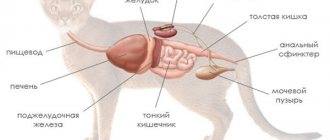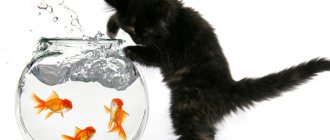Lilies are very popular and beautiful flowers, often found in homes and used as decorative decorations at many holidays. However, lilies of the genus Lilium and Hemerocallis have been shown to be capable of causing severe nephrotoxicity in cats when ingested. Those. substances contained in flower petals are toxic to kidney tissue. In order to be poisoned by lilies, a cat must eat them.
However, there is a certain amount of confusion about which flowers actually have a poisonous effect. After all, a lot of plants are called lilies. For example, flowers belonging to the genus Convallaria (lily of the valley), which are often confused with lilies, actually do not have a toxic effect on kidney tissue, but can seriously affect cardiac function (by analogy with cardiac glycosides, the drug digitalis). It is also worth remembering that there are many lily hybrids, the effect of which can be quite unpredictable.
Most owners are unaware that lilies can be potentially dangerous to their pets, but cats are extremely sensitive to the toxic effects of these flowers. It should be noted that the entire flower (petals, stamens, pistils) is poisonous to cats.
The exact dose and which toxins have a poisonous effect have not yet been precisely clarified, but, according to clinical observations, a very small part of the flower can provoke a severe attack (for example, a couple of petals).
The rapid onset of an attack indicates that toxins are absorbed very quickly. The kidney tubules are the first to be damaged.
Symptoms of lily poisoning in cats
In order for the toxins contained in lilies to begin their destructive effect, they must enter the cat’s gastrointestinal tract. Moreover, the dose sufficient for severe poisoning is quite insignificant: just two petals can cause a serious nephrotoxic effect in an animal.
In other words, lily toxins most strongly affect the kidney tissue, and the kidney tubules are the first to be affected. These toxic substances are absorbed into the blood of cats very quickly, and therefore the clinical picture of lily poisoning usually does not take long to appear.
The following signs may indicate that your pet is poisoned by lily juice:
- Increased salivation.
- Vomit.
- Refusal of food.
- Depressive state.
- Polyuria (the cat urinates frequently and a lot).
- Dehydration.
- Subsequently, anuria may develop (the pet cannot go to bed)
- Further, the cat may fall into a lethargic state, turning into coma and death.
Important!
Poisoning with pollen from lily plants occurs with the same clinical symptoms as intoxication with their juice, therefore, in order to avoid the possibility of poisoning, it is not enough to simply not allow your pet to chew the petals or leaves of lilies and lick the pollen. It is necessary to isolate it from flowering plants: put the bouquet in a place inaccessible to the pet. If the season of flowering lilies has begun, then, if there are any on the site, either do not let the cat into the yard at all, or during walks, carefully monitor that it does not approach dangerous plants.
Dangerous types of lilies
It is important to know that many plants have the word "lily" in their name, and they have varying toxic effects on cats. The most dangerous are:
- Hemerocallis species (Daylily, or Red Daylily)
- Lilium x asiatica (Asiatic lily)
- Lilium x asiatica americana
- Lilium candidum (Snow white lily, or pure white lily, or white lily)
- Lilium hydridum (Hybrid lily)
- Lilium lancifolium (Lilium tigrinum)
- Lilium longiforum (Lily Longiflorum)
- Lilium orientalis (oriental lily hybrids)
- Lilium regale (Regal lily, or royal lily, or Tibetan lily, or regale lily, or Chinese lily)
- Lilium speciosum (Lily beautiful, or beautiful lily)
- Lilium rubrum (Lily Rubrum)
- Lilium umbellatum
These types of lilies cause kidney damage in cats. All parts of the plant are toxic, and even a small amount of the plant, sap, or pollen can have serious consequences. Also dangerous is pollen that gets on the cat's fur and the water in which the flowers stand.
Diagnostics
You should not make diagnoses yourself, as the likelihood of error is quite high.
Even if the owner saw that his pet was gnawing on lilies, the diagnosis still needs to be entrusted to a specialist. Therefore, it is recommended that at the first signs of poisoning, take your pet to a veterinary clinic so that specialists can conduct a series of tests based on which they can give him the correct diagnosis.
What kind of research, besides a general examination of the animal, may be needed if a cat is suspected of being poisoned by lily toxins?
- General blood analysis.
- General urine analysis.
- Biochemistry of blood.
- Ultrasound of internal organs.
Important!
Before making a correct diagnosis, you should under no circumstances begin to treat your pet on your own. In the same case, if a trip to the clinic is temporarily impossible for one reason or another, it is permissible to provide first aid to the cat without resorting to the use of medications other than sorbents, such as activated carbon.
Signs of poisoning
Veterinarians, as well as owners, have noted the main signs that appear in the case of cat intoxication:
- weakness, drowsiness, loss of coordination,
- vomiting, diarrhea, foam at the mouth or nose,
- loss of appetite (lack of it), constant thirst,
- limb spasms.
Depending on what caused the poisoning, the symptoms that appear depend. Let us note the typical signs of intoxication that are observed in a cat when poisoned.
Treatment
If a cat is poisoned by lilies, it is recommended to treat it in a hospital setting.
The fact is that damage to the kidney tissue develops with lightning speed during this intoxication, and only timely therapeutic measures, such as intravenous infusions of electrolytes and plasma substitutes aimed at restoring blood flow in the kidneys and glomerular filtration, can save the cat.
In the case of lily poisoning, when treatment was not started in a timely manner, there is a very high probability that the animal’s kidneys will fail within 36-72 hours.
If treatment was started on time, and acute renal failure has not yet had time to enter the anuria phase (an animal’s condition in which urination completely stops), then the pet is likely to recover and will even probably avoid the negative consequences of poisoning for its health. If the anuric stage has already begun, the cat is often prescribed peritoneal dialysis as a last resort therapeutic measure. But even after dialysis, if the cat’s intoxication is too severe and anuria has also begun, a cure is not always possible.
Important!
In order not to miss time and start treatment on time, it is necessary to take the pet to the clinic as soon as the owner or one of his family members sees that the cat is gnawing on a lily.
In the same case, if for some reason this cannot be done immediately, it is necessary to immediately begin providing first aid to the animal, which consists of the following:
- Immediately rinse the cat's stomach. To do this, you can pour 15-20 ml of water into her mouth through a syringe without a needle, then press on the root of her tongue to induce vomiting.
- Give your pet sorbent. If there are no veterinary sorbents at home, then you can simply give the cat half a tablet of activated carbon diluted in 5 ml of water. This solution must be poured into the cat’s mouth through a syringe without a needle.
- Give the animal something to drink. If it does not drink on its own, then you need to pour 5 ml of water into its mouth every 15 minutes; this is also most conveniently done from a syringe with the needle removed from it.
- At the first opportunity, it is necessary to take the cat to the veterinarian for examination, even if, at first glance, his condition has already stabilized.
Important!
Under no circumstances should you feed the animal until the doctor allows it and prescribes a diet for the cat.
Lilies and Toxicity in Cats – Tips for Pets – 2021
The beautiful lily is one of the most commonly used flowers in floral arrangements, and they are also popular as potted plants to make an attractive addition to the home.
Unfortunately, however, if your home is also home to a cat, you should know that lilies are also extremely poisonous to our feline companions, and you should not leave lilies of any type inside the house if at all possible.
If it comes as a surprise to you that lilies can poison cats and you're wondering about the risks involved and how to keep your cat safe, read on to learn more about lily poisoning in cats, how to identify symptoms and how to prevent this.
What effect does lilies have on cats?
Like many plants, lilies are simply not suitable for feline consumption. The entire lily plant is toxic to cats; which includes pollen, leaves, roots, petals and everything else, which means cut lilies in vases and growing lilies in pots are equally dangerous.
Once a cat ingests lilies, either intentionally or unintentionally, the toxin present in the plant is absorbed by the buds, which ultimately, if left untreated, causes fatal or permanent kidney damage and severe pain and illness.
What types of lilies are poisonous to cats?
As far as we currently know, all types and varieties of lilies can potentially be poisonous to cats and in every format they come in - cut, dried or potted. Some of the most commonly found types of lilies that are known to be poisonous to cats include:
- Easter lily
- Tiger Lily
- Japanese show lily
- Ruby lily
- Day lily
- Some other members of the Liliaceae flower family
Many other varieties of lesser-known lilies are also toxic to cats, so it's safe to assume that any variety of lilies could potentially be harmful to your cat.
Looking for free pet advice? Click here to join the UKs favorite pet community - PetForums.co.uk
How do cats come into contact with lilies?
Cats will sometimes intentionally eat or bite lily leaves or flowers, although this is relatively rare. Kittens are likely to eat or bite flowers of any type as they explore the world around them.
But the most common risk for cats from eating lilies comes from the lily's pollen.
Lilies tend to drop a significant amount of pollen, which can easily be picked up on your cat's paws or rubbed onto a coat, then ingested when your cat washes and sits down.
Symptoms of lily poisoning in cats
Only a very small amount of pollen or one small leaf or petal is needed to make your cat sick quite quickly. After ingestion, symptoms begin to appear within a few hours or even within half an hour in some cases.
Be aware of these early symptoms that will begin to develop in just a few hours:
- Nausea and vomiting
- Lethargy and disinterest in what is happening around them
- Lack of appetite
As the poisoning progresses, it will begin to affect the kidneys, leading to localized pain in that area and general illness and unhappiness. If left untreated, it can lead to kidney failure and painful death.
If you know or suspect that your cat has been exposed to lilies, even a small amount, don't wait to see if symptoms develop.
Call your vet as a matter of urgency and be prepared to take them to surgery immediately.
Time is of the essence here, as your veterinarian may want to induce vomiting in your cat to remove any remaining lily in the stomach and help minimize the amount your cat ingests.
Treatment of lily poisoning in cats
If you are able to get your cat to the vet quickly, your veterinary surgeon may be able to give your cat a compound to encourage them to vomit any remaining portion of the lily in their stomach or consume the remainder.
If treatment for lily consumption is started within four to six hours of eating it, the cat will have a good chance of eventually recovering, so time is of the essence to try to prevent kidney damage and possible kidney failure.
Your cat will require hospitalization and close monitoring for at least 72 hours after ingestion to watch for signs of kidney failure and respond to any problems that arise.
Your cat may be placed on IV fluid therapy to keep them hydrated and also potentially given medications to control nausea and vomiting.
This is not a type of treatment that can be administered at home, and veterinary supervision is necessary to address any problems that arise along the way.
Keeping lilies away from cats
There's really no foolproof way to keep lilies in a home that contains cats, even if you have a room that is outside the cat's boundaries or a shelf that your cat can't reach. Lilies cast significant amounts of pollen, and so lily pollen can be found on the ground and furniture under high shelves, and is also tracked throughout the home by people and other pets.
The best way to prevent your cat from coming into contact with lilies is that you do not allow lilies to be brought into your home.
Source: https://rus.battlepetsonline.com/lilies-toxicity-cats-52822
Rehabilitation process
After providing pediatric assistance and carrying out the necessary procedures, owners are usually allowed to take the poisoned pet home.
The only exceptions to this rule are extremely severe cases of intoxication, when the animal must constantly be under IV drips or dialysis. Then he will be kept in a hospital until his general condition stabilizes.
In any case, after bringing the sufferer home, cat owners need to follow all the doctor’s recommendations, including how, what and how many times a day to feed, what medications to give, and how often to go to the clinic to monitor the pet’s condition.
Important!
In the event that IVs were prescribed, but the cat was not left in the hospital, the owners will have to take him to the clinic for procedures at the appointed time. Violation of this regime is completely unacceptable, since at the slightest deviation from following the doctor’s recommendations, the cat may develop severe complications caused by damage to the kidney tissue.
Lily poisoning is considered very dangerous for cats, but the likelihood of developing serious complications depends to a large extent on the individual characteristics of the animal. Some cats are more susceptible to lily toxins, others less so. Some of the purrs recover after minimal therapy and do not experience any consequences of poisoning in the future.
Others need weeks of dialysis to allow their kidney tissue to begin to recover. However, in many pets, unfortunately, the kidneys do not begin to function normally despite all the measures taken and they die within a few days after their fateful “acquaintance” with flowers.
Recovery
When first aid has been provided to the cat and his condition has stabilized and does not cause concern, he is allowed to be taken home. With severe consequences of intoxication, animals remain in the inpatient department longer. Before discharge, the doctor talks with the owners about care, feeding and treatment at home. Prescribes medications for home treatment. For at least 3 months after poisoning, cats are prescribed a dietary diet, so they are fed food intended for sensitive digestion. It is recommended to visit a veterinarian regularly to monitor the animal's condition.
Conclusion
To prevent a cat from being poisoned by lilies, you must follow simple rules: do not place bouquets of these flowers in the room where the animal is, and outside the city or in a private house, do not allow your pet to approach the flowers, smell them, or, when lilies are in bloom, Moreover, chew them.
If an accident happens and the cat does eat lilies, then it is necessary to take him to the clinic as soon as possible or immediately begin providing first aid to the pet if for some reason a trip to the doctor is impossible.
How to prevent cat poisoning?
If the pet is in a summer cottage, then such plants cannot be planted there.
Whenever possible, you need to keep an eye on your pet and not bring home flowers of the lily family. If you have garden plots, you should not plant plants on them that are poisonous to cats. If you notice that your cat is eating flower petals, it is recommended to isolate him. Pets can also be poisoned by substances in the house:
- household chemicals (washing powders and detergents);
- medications for people that they don't always hide;
- automotive chemicals (antifreeze causes the same consequences as lily poisoning);
- cosmetical tools;
- some dessert people food products.
All potential drugs that can provoke intoxication in a pet must be kept in an inaccessible place; they are hidden not only from children. It is necessary to monitor the behavior of the pet; unusual behavior or refusal to eat should alert the owners and prompt them to consult a doctor. If an animal has been poisoned by lilies, the sooner the cat’s owners visit the veterinarian, the more favorable the prognosis for its survival.
Dangerous varieties of lilies
Lilies are a perennial bulbous crop, of which more than 115 varieties are known. Not every variety of flower is poisonous to cats. The most toxic plant species:
Spathiphyllums and callas are mistakenly classified as relatives of lilies, although they are a separate family. They are relatively safe for the health of furry pets. They only have an irritating effect on the condition of the mouth and larynx, but such disorders are easily treatable.











